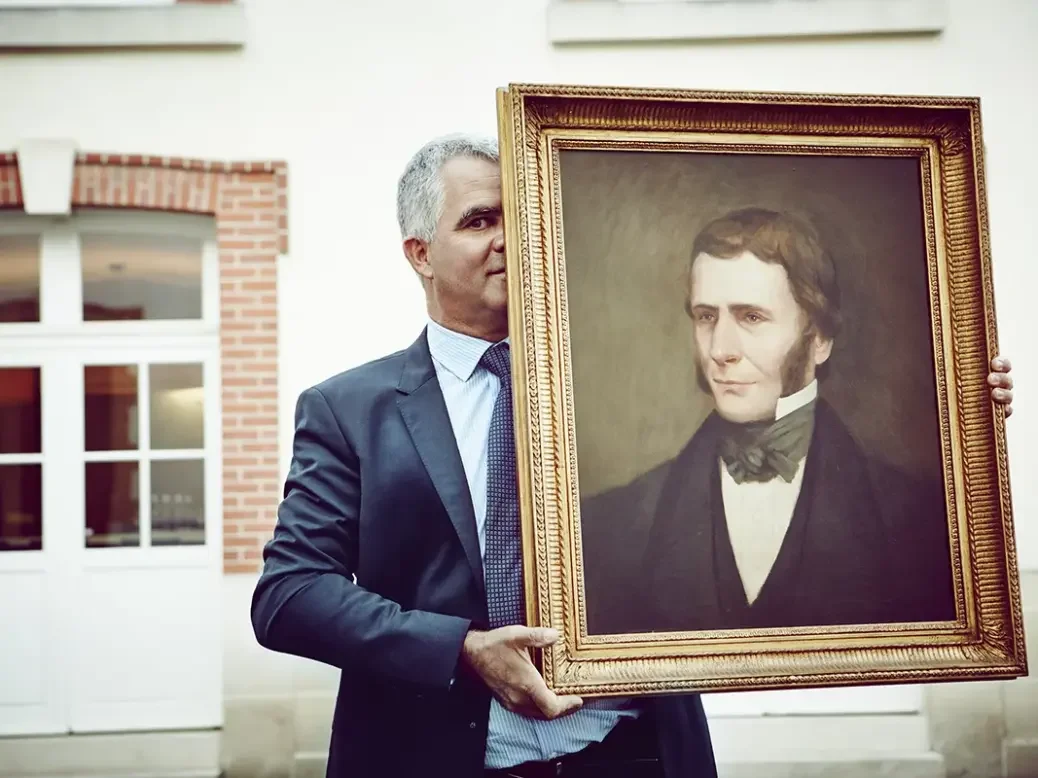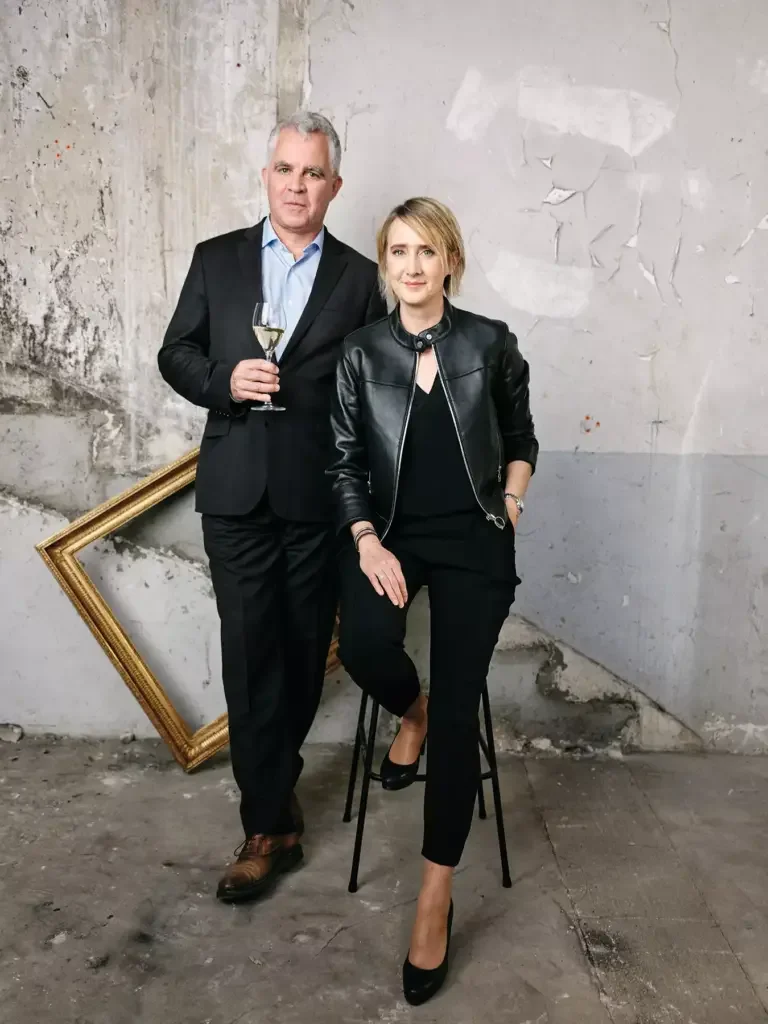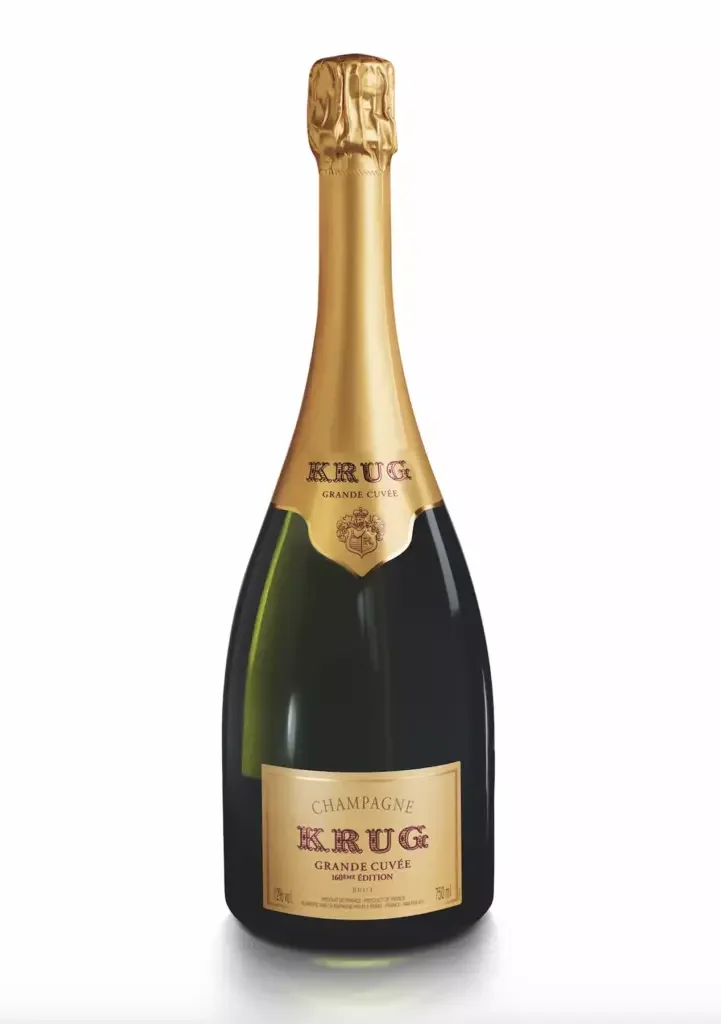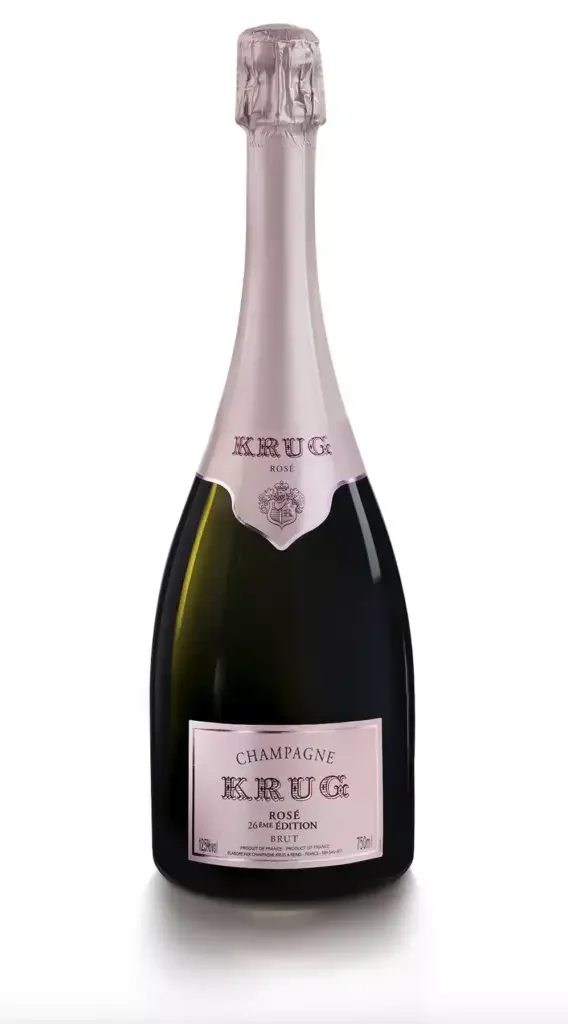
In 2016, Krug changed the habit of a lifetime and began publicizing the base vintage of each edition of its Krug Grande Cuvée and Krug Rosé. Anne Krebiehl MW reports on a tasting that would not have been possible before this new era of transparency.
Ostensibly, the invitation to come to Reims was to celebrate the 180th anniversary of the founding of the house of Krug in 1843 and the release of the latest wines, the 171st edition of Krug Grande Cuvée and the 27th edition of Krug Rosé. But the visit highlighted another milestone—a more recent achievement and the result of a complete rethink not of winemaking but of communicating. What had started as a marketing exercise—designed to lay open the workings behind Krug’s Grande Cuvée in a contemporary, transparent fashion—ended up revealing more about this iconic wine than even Olivier Krug could have wished for.
Krug announced in 2016 that every Grande Cuvée would henceforth be numbered.1 Each new release would now be a distinct “edition,” starting with the 163rd edition released in 2016, based on the 2007 vintage, counted from Joseph Krug’s first vintage in 1844. This idea—copied since by others—was a brilliant move. It allowed the house to make these now-distinguishable editions far more collectible, handing sales staff and sommeliers across the globe a new and convincing tool with Krug’s brand DNA at its core. It allowed Krug to tell and retell the story of Joseph Krug’s dream—namely, “to craft the very best Champagne he could offer, every single year, regardless of annual variations in climate”—and to turn each new release into a launch event, generating reviews, column inches, and sales.
Previously, once a Krug Grande Cuvée was released, it had joined all other releases of Grande Cuvée already on the market. Krug lovers appreciated its rich, savory style but were none the wiser. Admittedly, ever since mid-2011 they could take a peek at the six-digit Krug iD code, which would reveal the disgorgement date and details of the blend, but that was all the information that was available—even if you did know where to look.2 The driving force behind all this was Maggie Henriquez, who had joined Krug as CEO in 2009.3 In the increasingly crowded and ever-evolving marketplace, the story of Krug had to be retold to a new audience. She revamped the house by putting its founding story at the heart of the brand, insisting on longer pre- and post-disgorgement aging, and with her awareness of the importance of transparency, introduced the Krug iD. Still wedded to a now-obsolete idea in Champagne, Henriquez had initially been “adamant that the code should never explicitly specify the principal vintage on which a particular Grande Cuvée was based, because that would be antithetical to the multi-vintage ethos,” reported Jancis Robinson MW at the time4. How things have changed. Just a little latent selling craftsmanship and expertise, and she made sure Krug did this well. Since 2016, each new launch of Krug Grande Cuvée has been celebrated with much more detail and information provided.

As an annual (or year-after-year) exercise, journalists are invited to Reims to experience what goes into making Krug. I had the pleasure back in 2017, when Eric Lebel was still in charge. This year, I had this pleasure again, with the added bonus of visiting and tasting Clos du Mesnil. Rather than just present the latest edition—number 171, created on the basis of the 2015 vintage—there was the addition of a vertical tasting, not just of Grande Cuvée but of Krug Rosé, too. Cellar master Julie Cavil said, “We are going through an extremely rare tasting that would not have been possible ten years ago; we are going through ten different circumstances of harvest, ten different editions of Krug Grande Cuvée. This is the purpose of this tasting, that regardless of the work behind the scenes, it is always a different creation, but always with the same inspiration: the fullest expression Champagne can give us in one glass.” Olivier Krug himself added, “Even I was not expecting that communicating on the concept of Editions would have such a strong impact, as we had already introduced Krug iD over a decade ago. But bringing this information to the front label immediately gave the trade, teams, and Krug Ambassades a tangible way to speak about each creation of Krug Grande Cuvée. Each has its unique story, as a distinct blend, the annual recreation of the dream Joseph Krug had to craft the very best Champagne he could offer, every year, regardless of annual variations in climate.”
The vertical and the various compositions allow us to see that there is—and is not—a recipe at the same time. The wine is always a blend of three varieties and usually has similar proportions of reserve wines; this is how you have that savory, rich, complex Krug red thread through all the wines, while the impressions of the years shimmer through. With all that information, an element of mystery remains, because the exact proportion of vintages and varieties is not disclosed. However, the perpetuation of a style and an idea—of Joseph Krug’s dream—is clear. All of the wines have dosage levels of between 4 and 5 grams of sugar per liter.
Notes
1 thedrinksbusiness.com/2015/09/krug-to-number-each-grand-cuvee-blend
2 jancisrobinson.com/articles/fizz-and-fortified-more-information-please
3 It was announced in late 2008, and she started in 2009—some records differ here. But I am taking this as my cue: decanter.com/wine-news/krug-appoints-new-ceo-75398
4 jancisrobinson.com/articles/id-codes-for-krug-grande-cuvee
Tasting
Krug Grande Cuvée 171ème Edition
(Recreated around the 2015 vintage; 58% 2015, 42% reserve wines; 37% Chardonnay, 45% Pinot Noir, 18% Pinot Meunier; 131 different wines from 12 years, the 2000 vintage the oldest in the blend)
Krug chef de cave Julie Cavil notes that the 2015 vintage was marked by “heat and sun and providential rain in August.” In a year that posed difficulties for Champagne due to a certain lack of tension, she remarks, “There was no blockage of maturity; it was hot but without extremes during ripening. We went into our reserve wines to bring the famous lime and grapefruit. So, we had to blend with 2014, 2008, 2004, which are cooler harvests.”
An immediate sense of apricot on the nose, laced with lemon and a slight smokiness. A little more air and time in the glass bring crushed butter biscuit and salty, wet oyster shell. The palate is fresh; the mousse is still strident and very lively. There is a lovely grapefruit edge, tingling with saltiness. Very mouthwatering, very energetic, and muscular yet elegant. Beautiful length of lemon-inflected wet chalk. Absolutely cleansing. 95
Krug Grande Cuvée 170ème Edition
(Recreated around the 2014 vintage; 55% 2014, 45% reserve wines; 38% Chardonnay, 51% Pinot Noir, 11% Pinot Meunier; 195 different wines from 12 years, the 1998 vintage the oldest in the blend)
Cavil noted that 2014 was a “more classical year” than 2015. She recalled that this was the year they faced the invasive spotted-wing fruit fly Drosophila suzukii, “which destroyed a lot of Pinot Noir in the Montagne de Reims—
and we rely a lot on this Pinot Noir. We lost our Clos d’Ambonnay, we lost our red-wine plot, so we had to count on other things to bring back the structure.”
A very subtle nose, rather shy and really savory: smoked cashew and cashew butter. The mousse is lively, reveals smoky layers, smoldering depth, alongside lemony brightness. Its zestiness is amplified by salty notions of dried cèpe and salty umami, a silver vein of citric verve running right through. Absolute lemon length and purity. 96
Krug Grande Cuvée 169ème Edition
(Recreated around the 2013 vintage; 60% 2013, 40% reserve wines; 35% Chardonnay, 43% Pinot Noir, 22% Pinot Meunier; 146 different wines from 11 years, the 2000 vintage the oldest in the blend)
A hint of briny oyster shell, as well as recently snuffed-out candle on the nose. Toasted rye sourdough and wonderful resonance, too. The palate is taut, filling the mouth with a smoky chalkiness that seems to draw you right back down into the soil. Yet the mousse foams and sprays with the richness of seaweed crackers and crushed, roasted salty hazelnut. Utterly mouthwatering, with very subtle, very salty hints of cashew and miso. 96
Krug Grande Cuvée 168ème Edition
(Recreated around the 2012 vintage; 58% 2012, 42% reserve wines; 35% Chardonnay, 52% Pinot Noir, 13% Pinot Meunier; 198 different wines from 11 years, the 1996 vintage the oldest in the blend)
A nose as dramatic as the year: hints of cold butter, framed with nori and the smokiness of dashi, highlighted with candied lemon peel. The richness and brightness continue on the palate, guided by an Amalfi-lemon luminosity. The mousse is wonderfully smooth, the benefit of age. Wonderful resonance and lovely depth, with much fruit, juiciness, and flow. 96
Krug Grande Cuvée 166ème Edition
(Recreated around the 2010 vintage; 58% 2010, 42% reserve wines; 39% Chardonnay, 45% Pinot Noir, 16% Pinot Meunier; 140 different wines from 13 years, the 1998 vintage the oldest in the blend)
A first hint of evolution, the slightest whiff of dried cèpe mushroom and fresh lemon browned in a cast-iron pan, duxelles dressed with lemon juice: a mix of savoriness and citric brightness. The palate also shows an edge of evolution, an aromatic intensity and a verticality and tautness that is only accentuated by the fine mousse, alongside the salty, chalky backdrop. Very elegant, almost severe, but with glorious depth. Wonderful. Fizzing with electricity and vibrant linearity. 96+
Krug Grande Cuvée 165ème Edition
(Recreated around the 2009 vintage; 69% 2009, 31% reserve wines; 38% Chardonnay, 47% Pinot Noir, 15% Pinot Meunier; 127 different wines from 12 years, the 1990 vintage the oldest in the blend)
A hint of dried-apple tisane, immediately followed by an intense hint of ripe Amalfi lemon peel and fresh, creamy bakers’ yeast, verging into wet chalk and briny oyster, then swinging back to Golden Delicious apple flesh. The palate is utterly salty and savory, foaming with gentle, creamy mousse, the white miso savoriness having inflections of white pepper, salted butter and roasted cashew, and flickers of lemon zest. Very complex. 94

Krug Grande Cuvée 164ème Edition
(Recreated around the 2008 vintage; 68% 2008, 32% reserve wines; 35% Chardonnay, 48% Pinot Noir, 17% Pinot Meunier; 127 different wines from 11 years, the 1990 vintage the oldest in the blend)
Julie Cavil noted that “because 2008 was so perfect, less reserve wine was needed.” Subtle cold butter, a smattering of white pepper, freshly baked rye-sourdough crumb with a smoky echo of dried cèpe. Another whiff offers white peach, tender stone fruit, and gloriously pure lemon. The palate strikes with its immediate notion of chalky depth, of tautness and elegance, the impression heightened by the subtle, very fine mousse. A sleeper of immense subtlety and elegance. Very long. Very understated, but it (absolutely) lingers under your skin. 97
Krug Grande Cuvée 163ème Edition
(Recreated around the 2007 vintage; 73% 2007, 27% reserve wines; 32% Chardonnay, 37% Pinot Noir, 31% Pinot Meunier; 145 different wines from 12 years, the 1990 vintage the oldest in the blend)
This was the first Krug Grande Cuvée to be released as a numbered edition.
A gorgeous creaminess and golden dried-apple richness appear first on the nose and are followed by the savory hit of Japanese seaweed cracker. Evolution comes in the form of dried lemon and dried cèpe. The palate is juicy, chalky, absolutely grounded in soil, yet shining with Mirabelle fruit. This is generous and fruity yet utterly savory, salty, zesty. Beautifully mesmerizing. At a perfect juncture of evolution, with a bitter hint of citrus peel and beeswax. Glorious. 96
Krug Grande Cuvée 162ème Edition
(Recreated around the 2006 vintage; 60% 2006, 40% reserve wines; 35% Chardonnay, 44% Pinot Noir, 21% Pinot Meunier; 163 different wines from 11 years, the 1990 vintage the oldest in the blend)
Lifted notes of slightly caramelized apricot skin, as on the top of a frangipane apricot tart. The fine mousse on the palate underscores that scorched, slightly butter and lemon-edged richness. Mouthwatering, lifted, edges of beeswax, seems more advanced. 94
Krug Grande Cuvée 160ème Edition
(Recreated around the 2004 vintage; 65% 2004, 35% reserve wines; 33% Chardonnay, 44% Pinot Noir, 23% Pinot Meunier; 121 different wines from 12 years, the 1990 vintage the oldest in the blend)
Lifted candied lemon alongside dried lemon peel on the nose. The palate has a gentle waxiness, a lemon brightness, salty white miso paste, and signs of evolution: subtle white field-mushroom earthiness, but countered by vivid, fresh, pale-lemon lightness; the body is fine, slender, juicy. More air brings hints of wet pebble, lovely stoniness, hints of petrichor. Very, very subtle, very charming. Totally touching. Utterly lemon-focused and so, so salty on the finish. Lip-smacking, pure, long. Wow. 96
KRUG ROSÉ
The spectacular white vertical was followed by a smaller Rosé vertical. “I am always surprised that it is only 27 times that we have produced Krug Rosé—it is almost a work in progress,” Cavil said. “So, why did Maison Krug remain a house without rosé?” she asks. “In the 1970s, Krug was already renowned for its art of blending, its generosity and complexity. And in the ’70s, rosé wines were seen as easy to drink, with a lot of fruit, sometimes with a little more sugar. The house of Krug said, No, this cannot be reconciled. But then they thought a lot and decided to capitalize on the philosophy of Krug Grande Cuvée and decided it should be a Krug before being a rosé. It is one of the most difficult blends to make every year. It is an improvisation in a sense, it is more jazz, while Grande Cuvée is more like a symphony orchestra—this is more like chamber music.”
Olivier Krug added that the very first Krug Rosé edition came out in the 1980s, based around the 1976 vintage. “1976 was a good opportunity to make this experiment,” he says, “It was a gastronomic rosé from the beginning, and they experimented a lot with chefs; very few people were doing food pairing in Champagne [at the time]. It was like a provocation—it was a big discovery.”
Cavil then adds more about the blending process of the rosé. “It is the same philosophy,” she says, “but with a lower amplitude, with fewer individualities inside the blend, so each individuality has a bigger share of voice in the blend. It is trickier, we have to select very intense individualities. We have to make a Champagne, so we need to have elegance, straightness, ethereal texture… But then you add red wine, with concentration, with tannin, with a lot of fruit, and you have to reconcile this, so we never take the white base of Krug Grande Cuvée. It is a completely different white base. I select wines with more roundness, more maturity, so we build a white base with more roundness, with a cushion to welcome the red wine. We have to find a balance between finesse and substance. The 27th edition of Krug Rosé leaves the cellar right now, and it is based around harvest 2015.”
Krug Rosé 27ème Edition
(Recreated around the 2015 vintage; 45% 2015, 55% reserve wines; 23% Chardonnay, 57% Pinot Noir, 20% Pinot Meunier, 10% of the wine vinified red; 38 different wines from nine years, the 2005 vintage the oldest in the blend)
A dark copper color, with a subtle scent of umeshu plum, lemon, cherry, and plum skin alongside caramel on a fragrant brioche. The rich, smooth palate is fluid and smooth, with a fine mousse and a subtle note of lifted, dried cherry. This is bold and rich, unashamed, present. The finish has vivid lemon and tapers the rich, rounded palate into a wonderfully salty finish. 94
Krug Rosé 26ème Edition
(Recreated around the 2014 vintage; 67% 2014, 33% reserve wines; 30% Chardonnay, 44% Pinot Noir, 26% Pinot Meunier, 11% of the wine vinified red; 28 different wines from seven years, the 2005 vintage the oldest in the blend)
A lovely nose of Red Delicious flesh speaks of Pinot Noir on the nose, followed by whipped double cream, rye sourdough, and vivid notes of white pepper. The palate is lively, creamy, and flecked with tart red-berry aromas but streaked with citrus, wonderfully concentrated and focused, creamy, precise, energetic, and vibrant. 95
Krug Rosé 24ème Edition
(Recreated around the 2012 vintage; 29% 2012, 71% reserve wines; 28% Chardonnay, 40% Pinot Noir, 32% Pinot Meunier, 11% of the wine vinified red; 22 different wines from seven years, the 2006 vintage the oldest in the blend)
An initial touch of reductive flintiness segues into notions of fresh white field mushroom, more white pepper, and a smoldering, smoky flicker. The palate has wonderfully creamy mousse and quite some richness, a texture of denser sponge cake with a slightly bitter edge reminiscent of citrus pith. Wonderfully mouthwatering, with the glow of bright, aromatic, ripe redcurrant and more peppery spice. That lovely phenolic edge absolutely calls for food. A wonderfully vibrant, lasting, memorable wine. 95

Krug Rosé 21ème Edition
(Recreated around the 2008 vintage; 34% 2008, 66% reserve wines; 41% Chardonnay, 51% Pinot Noir, 8% Pinot Meunier, 10% of the wine vinified red; 22 different wines from seven years, the 2006 vintage the oldest in the blend)
Chalky cream is the first impression on the nose, some Red Delicious flesh flashes up with rich fruitiness, edged with white pepper and rye sourdough. The palate has a mellower vibe, subtle but with the merest hint of apple-pip bitterness buffered with immense creaminess. With more air, hints of orange peel pop up, always accompanied by that creamy chalk sensation. Much substance here, but in an incredibly elegant package. The salty finish is totally mouthwatering. 95
Krug Rosé 19ème Edition
(Recreated around the 2006 vintage; 78% 2006, 22% reserve wines; 33% Chardonnay, 59% Pinot Noir, 8% Pinot Meunier, 10% of the wine vinified red; 37 different wines from five years, the 2000 vintage the oldest in the blend)
The nose immediately fills with an intense note of duxelles, edged with hints of lifted beeswax and candied lemon. The palate also shows clear signs of evolution and a gentle, dried-apple-skin bitterness. There is even a vestige of leather, on a palate that has a fine mousse and much concentration, much richness, shimmering with notes of caramelized apricot and salty preserved lemon. Savory and very salty. Drink soon. 93






